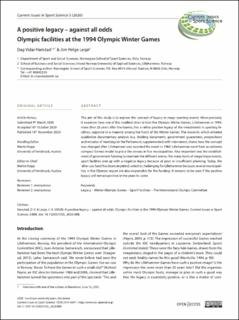| dc.contributor.author | Hanstad, Dag Vidar | |
| dc.contributor.author | Lesjø, Jon Helge | |
| dc.date.accessioned | 2021-02-02T07:01:34Z | |
| dc.date.available | 2021-02-02T07:01:34Z | |
| dc.date.created | 2020-12-18T08:32:31Z | |
| dc.date.issued | 2020 | |
| dc.identifier.citation | Current Issues in Sport Science. 2020, 5, 008. | en_US |
| dc.identifier.issn | 2414-6641 | |
| dc.identifier.uri | https://hdl.handle.net/11250/2725686 | |
| dc.description | CISS applies the Creative Commons Attribution License CC BY-NC to works we publish. This license was developed to facilitate open access – namely, free immediate access to, and unrestricted reuse of, original works of all types. | en_US |
| dc.description.abstract | The aim of this study is to explore the concept of legacy in mega sporting events. More precisely, it examines how one of the smallest cities to host the Olympic Winter Games, Lillehammer in 1994, more than 25 years after the Games, has a rather positive legacy of the investments in sporting facilities, opposite to a majority among the hosts of the Winter Games. The research, which entailed qualitative documentary analysis (e.g. bidding documents, government guarantees, white papers and minutes of meetings in the Parliament, supplemented with interviews), shows how the concept was changed after Lillehammer was awarded the event in 1988. Lillehammer went from an extreme compact Games model to place the venues in five municipalities. Also important was the establishment of government funding to maintain the different arenas. For many hosts of mega/major events, sport facilities end up with a negative legacy because of poor or insufficient planning. Today, the ‘after-use fund’ has been depleted, which is challenging for Lillehammer because several municipalities in the Olympic region are also responsible for the funding. It remains to be seen if the positive legacy will remain positive in the years to come. | en_US |
| dc.language.iso | eng | en_US |
| dc.relation.uri | https://webapp.uibk.ac.at/ojs2/index.php/ciss/article/view/3272 | |
| dc.subject | legacy | en_US |
| dc.subject | sport facilities | en_US |
| dc.subject | The International Olympic Committee | en_US |
| dc.subject | IOC | en_US |
| dc.subject | Winter Olympic Games | en_US |
| dc.subject | environment | en_US |
| dc.title | A positive legacy – against all odds: Olympic facilities at the 1994 Olympic Winter Games | en_US |
| dc.type | Peer reviewed | en_US |
| dc.type | Journal article | en_US |
| dc.description.version | publishedVersion | en_US |
| dc.rights.holder | © The author retains unrestricted copyrights and publishing rights | en_US |
| dc.source.pagenumber | 14 | en_US |
| dc.source.volume | 5 | en_US |
| dc.source.journal | Current Issues in Sport Science | en_US |
| dc.identifier.doi | https://doi.org/10.15203/CISS_2020.008 | |
| dc.identifier.cristin | 1861353 | |
| dc.description.localcode | Institutt for idrett og samfunnsvitenskap / Department of Sport and Social Sciences | en_US |
| dc.source.articlenumber | 008 | en_US |
| cristin.ispublished | true | |
| cristin.fulltext | original | |
| cristin.qualitycode | 1 | |
